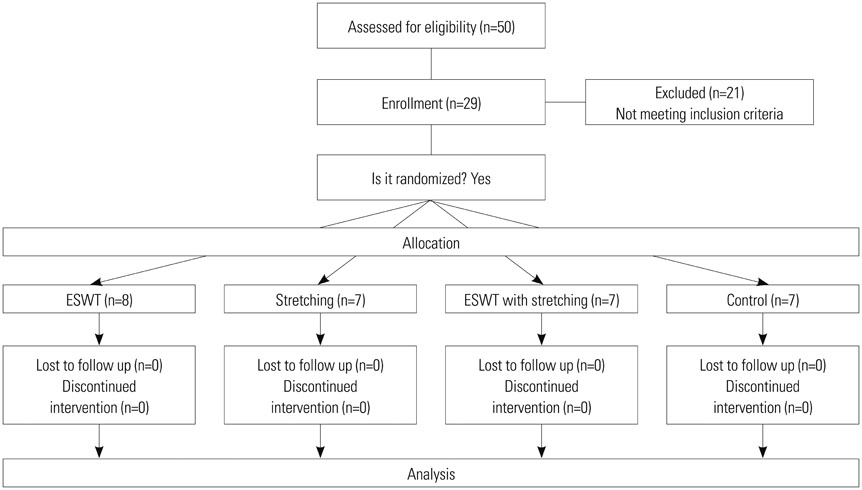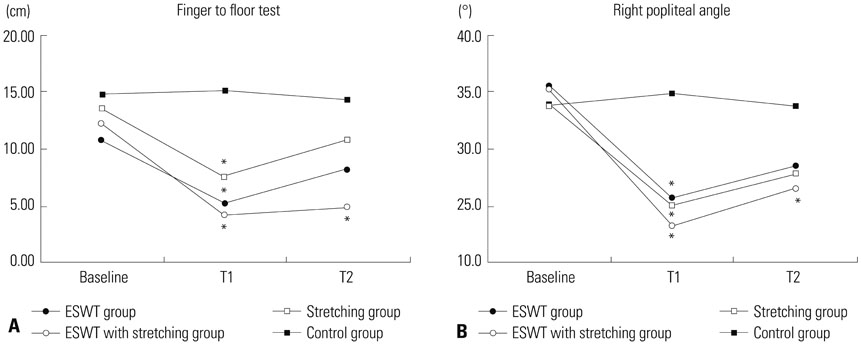Yonsei Med J.
2017 May;58(3):644-649. 10.3349/ymj.2017.58.3.644.
Effect of Extracorporeal Shock Wave Therapy on Hamstring Tightness in Healthy Subjects: A Pilot Study
- Affiliations
-
- 1Department of Rehabilitation Medicine and Research Institute, Yonsei University College of Medicine, Seoul, Korea. bettertomo@yuhs.ac
- 2Department of Physical and Rehabilitation Medicine, Samsung Medical Center, Sungkyunkwan University School of Medicine, Seoul, Korea.
- KMID: 2419125
- DOI: http://doi.org/10.3349/ymj.2017.58.3.644
Abstract
- PURPOSE
To assess the effect of extracorporeal shock wave therapy (ESWT) for healthy participants with hamstring tightness.
MATERIALS AND METHODS
This study was performed at a university rehabilitation hospital. Twenty nine healthy adults with hamstring tightness were enrolled and randomly allocated into four groups (ESWT, stretching exercise, ESWT with stretching exercise, and control). The effects of individual treatments were compared by the finger-to-floor test and popliteal angle.
RESULTS
The ESWT group, stretching exercise group and ESWT with stretching exercise group had decreased finger-to-floor distances and right popliteal angles immediately after intervention, compared with the control group (p<0.05). At 4 weeks after completion of the interventions, finger-to-floor distances and the right popliteal angle in only the ESWT with stretching exercise group showed a significant improvement, compared with the control group (p=0.008 and 0.023).
CONCLUSION
While ESWT and stretching both reduced hamstring tightness immediately after interventions, only ESWT with stretching exercise maintained the significantly improved relief of hamstring tightness significantly after 4 weeks.
Keyword
MeSH Terms
Figure
Reference
-
1. Herring SW, Grimm AF, Grimm BR. Regulation of sarcomere number in skeletal muscle: a comparison of hypotheses. Muscle Nerve. 1984; 7:161–173.
Article2. Nishikawa Y, Aizawa J, Kanemura N, Takahashi T, Hosomi N, Maruyama H, et al. Immediate effect of passive and active stretching on hamstrings flexibility: a single-blinded randomized control trial. J Phys Ther Sci. 2015; 27:3167–3170.
Article3. Hultman G, Saraste H, Ohlsen H. Anthropometry, spinal canal width, and flexibility of the spine and hamstring muscles in 45-55-year-old men with and without low back pain. J Spinal Disord. 1992; 5:245–253.
Article4. Atamaz F, Ozcaldiran B, Ozdedeli S, Capaci K, Durmaz B. Interobserver and intraobserver reliability in lower-limb flexibility measurements. J Sports Med Phys Fitness. 2011; 51:689–694.5. Ayala F, Sainz de Baranda P, De Ste Croix M, Santonja F. Absolute reliability of five clinical tests for assessing hamstring flexibility in professional futsal players. J Sci Med Sport. 2012; 15:142–147.
Article6. d'Agostino MC, Craig K, Tibalt E, Respizzi S. Shock wave as biological therapeutic tool: from mechanical stimulation to recovery and healing, through mechanotransduction. Int J Surg. 2015; 24(Pt B):147–153.7. Bandy WD, Irion JM, Briggler M. The effect of static stretch and dynamic range of motion training on the flexibility of the hamstring muscles. J Orthop Sports Phys Ther. 1998; 27:295–300.
Article8. Gajdosik RL, Rieck MA, Sullivan DK, Wightman SE. Comparison of four clinical tests for assessing hamstring muscle length. J Orthop Sports Phys Ther. 1993; 18:614–618.
Article9. Gonkova MI, Ilieva EM, Ferriero G, Chavdarov I. Effect of radial shock wave therapy on muscle spasticity in children with cerebral palsy. Int J Rehabil Res. 2013; 36:284–290.
Article10. Ingraham SJ. The role of flexibility in injury prevention and athletic performance: have we stretched the truth? Minn Med. 2003; 86:58–61.11. Jeon JH, Jung YJ, Lee JY, Choi JS, Mun JH, Park WY, et al. The effect of extracorporeal shock wave therapy on myofascial pain syndrome. Ann Rehabil Med. 2012; 36:665–674.
Article12. Kim YW, Shin JC, Yoon JG, Kim YK, Lee SC. Usefulness of radial extracorporeal shock wave therapy for the spasticity of the subscapularis in patients with stroke: a pilot study. Chin Med J (Engl). 2013; 126:4638–4643.13. Lee JY, Kim SN, Lee IS, Jung H, Lee KS, Koh SE. Effects of extracorporeal shock wave therapy on spasticity in patients after brain injury: a meta-analysis. J Phys Ther Sci. 2014; 26:1641–1647.
Article14. Leone JA, Kukulka CG. Effects of tendon pressure on alpha motoneuron excitability in patients with stroke. Phys Ther. 1988; 68:475–480.
Article15. Berger W, Horstmann G, Dietz V. Tension development and muscle activation in the leg during gait in spastic hemiparesis: independence of muscle hypertonia and exaggerated stretch reflexes. J Neurol Neurosurg Psychiatry. 1984; 47:1029–1033.
Article16. Ciampa AR, de Prati AC, Amelio E, Cavalieri E, Persichini T, Colasanti M, et al. Nitric oxide mediates anti-inflammatory action of extracorporeal shock waves. FEBS Lett. 2005; 579:6839–6845.
Article17. Czaprowski D, Leszczewska J, Kolwicz A, Pawłowska P, Kędra A, Janusz P, et al. The comparison of the effects of three physiotherapy techniques on hamstring flexibility in children: a prospective, randomized, single-blind study. PLoS One. 2013; 8:e72026.
Article18. Dietz V, Sinkjaer T. Spastic movement disorder: impaired reflex function and altered muscle mechanics. Lancet Neurol. 2007; 6:725–733.
Article19. Vulpiani MC, Nusca SM, Vetrano M, Ovidi S, Baldini R, Piermattei C, et al. Extracorporeal shock wave therapy vs cryoultrasound therapy in the treatment of chronic lateral epicondylitis. One year follow up study. Muscles Ligaments Tendons J. 2015; 5:167–174.
Article20. Sohn MK, Cho KH, Kim YJ, Hwang SL. Spasticity and electrophysiologic changes after extracorporeal shock wave therapy on gastrocnemius. Ann Rehabil Med. 2011; 35:599–604.
Article21. Ansari NN, Adelmanesh F, Naghdi S, Tabtabaei A. The effect of physiotherapeutic ultrasound on muscle spasticity in patients with hemiplegia: a pilot study. Electromyogr Clin Neurophysiol. 2006; 46:247–252.22. Santamato A, Notarnicola A, Panza F, Ranieri M, Micello MF, Manganotti P, et al. SBOTE study: extracorporeal shock wave therapy versus electrical stimulation after botulinum toxin type a injection for post-stroke spasticity-a prospective randomized trial. Ultrasound Med Biol. 2013; 39:283–291.
Article23. McHugh MP, Connolly DA, Eston RG, Kremenic IJ, Nicholas SJ, Gleim GW. The role of passive muscle stiffness in symptoms of exercise-induced muscle damage. Am J Sports Med. 1999; 27:594–599.
Article24. Marques AP, Vasconcelos AA, Cabral CM, Sacco IC. Effect of frequency of static stretching on flexibility, hamstring tightness and electromyographic activity. Braz J Med Biol Res. 2009; 42:949–953.
Article25. Perret C, Poiraudeau S, Fermanian J, Colau MM, Benhamou MA, Revel M. Validity, reliability, and responsiveness of the fingertip-to-floor test. Arch Phys Med Rehabil. 2001; 82:1566–1570.
Article26. Thompson NS, Baker RJ, Cosgrove AP, Saunders JL, Taylor TC. Relevance of the popliteal angle to hamstring length in cerebral palsy crouch gait. J Pediatr Orthop. 2001; 21:383–387.
Article27. Witvrouw E, Bellemans J, Lysens R, Danneels L, Cambier D. Intrinsic risk factors for the development of patellar tendinitis in an athletic population. A two-year prospective study. Am J Sports Med. 2001; 29:190–195.
Article28. Witvrouw E, Lysens R, Bellemans J, Cambier D, Vanderstraeten G. Intrinsic risk factors for the development of anterior knee pain in an athletic population. A two-year prospective study. Am J Sports Med. 2000; 28:480–489.
Article29. Amelio E, Manganotti P. Effect of shock wave stimulation on hypertonic plantar flexor muscles in patients with cerebral palsy: a placebo-controlled study. J Rehabil Med. 2010; 42:339–343.
Article30. Zhang X, Yan X, Wang C, Tang T, Chai Y. The dose-effect relationship in extracorporeal shock wave therapy: the optimal parameter for extracorporeal shock wave therapy. J Surg Res. 2014; 186:484–492.
Article
- Full Text Links
- Actions
-
Cited
- CITED
-
- Close
- Share
- Similar articles
-
- Current Concepts in Extracorporeal Shock Wave Therapy
- Treatment of Nonunion of Tibia with Extracorporeal Shock Wave Therapy: A Case Report
- Suggestions for Effective Extracorporeal Shock Wave Treatment Methods for Lateral Epicondylitis
- Effects of Extracorporeal Shock Wave Lithortripsy Experimentally Induced Cholelithiasis and Organs in the Dog
- Dose Related Effect of Extracorporeal Shock Wave Therapy in Lateral Epicondylitis



